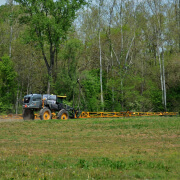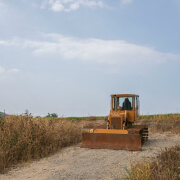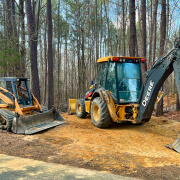How Land Clearing Can Help Prevent Wildfires
Wildfires are natural disasters that can have devastating effects on the environment and communities. These fires spread rapidly, consuming everything in their path. Understanding why wildfires occur can be the first step in taking preventive action. A significant factor in wildfire occurrences is dry vegetation and unkept land, which serve as fuel for these uncontrollable fires.
In places like Brisbane, where the climate can be quite dry, keeping the land clear is essential for reducing the risk of wildfires. While these landscapes can be picturesque, they also hold potential dangers if not managed properly. This is where land clearing comes into play. By removing excess vegetation and maintaining the land, we can significantly reduce the chances of a wildfire igniting and spreading.
Understanding the Risks: Why Wildfires Occur
Wildfires can start from various sources, including lightning strikes, unattended campfires, and even discarded cigarettes. However, the common link among these causes is the presence of dry vegetation, which acts as kindling. When land is left unkept, it accumulates brush, dead leaves, and dry grass, all of which contribute to fuel loads that make it easier for fires to start and spread.
The Role of Land Clearing in Fire Prevention
Land clearing is a proactive way to minimise wildfire risks by physically removing or thinning out excess vegetation. When you remove potential fuel sources, you greatly reduce the chance of a fire gaining momentum. It also helps create natural firebreaks, gaps in vegetation that can slow down or stop the progress of a wildfire. In essence, these firebreaks act like barriers, giving firefighters more time and space to manage the flames.
Firebreaks aren’t just for rural landscapes; they are increasingly important in suburban and urban settings that are close to bushland. Not only do they keep fires at bay, but they also provide strategically planned areas for wildlife to cross, ensuring animals have a safe passage even in the event of a fire.
Methods for Effective Land Clearing
There are both manual and mechanical methods for clearing land. Manual clearing involves using tools like chainsaws and sickles to cut through brush and small trees. This approach can be particularly effective for small areas where precision is needed. On the other hand, mechanical clearing uses machines such as bulldozers and large mowers, which can cover larger areas more quickly.
Here are some common techniques:
– Manual Clearing: Utilise handsaws and pruners for detailed work.
– Mechanical Clearing: Employ bulldozers for large-scale clearances.
– Controlled Burning: Conduct small fires under supervision to clear dead vegetation, though this requires strict regulatory compliance.
Professional land clearing services come equipped not only with the right tools but also with expertise in choosing the most appropriate method for each unique landscape. This ensures that the clearing is done safely and efficiently, reducing the likelihood of inadvertent environmental or structural damage. As you consider land clearing options, consulting with experts and planning carefully are key steps to ensuring both safety and successful outcomes.
Seasonal Considerations for Land Clearing in Brisbane
Brisbane’s climate plays a notable role in determining the optimal times for land clearing. Since the region experiences distinct wet and dry seasons, these conditions influence the practicality and effectiveness of land clearing activities. For best results, planning land clearing during the drier months, typically from June to August in Brisbane, can be advantageous. During this period, the ground is firmer and less muddy, making it easier for machinery to operate and reducing the risk of soil erosion.
The seasonal variations also impact the type of vegetation that needs to be cleared. In the wet season, growth bursts can lead to overgrown areas more commonly providing fuel for fires if left unchecked. Addressing these areas before the onset of summer greatly reduces wildfire risks. Additionally, scheduling your land clearing at a time that allows for easy access for machinery and minimal disruption from seasonal rains can lead to a more efficient and safer process.
Long-term Benefits of Regular Land Clearing
Regular land clearing confers a range of benefits beyond wildfire prevention. Well-maintained land presents fewer hazards and keeps property values stable. Regular upkeep ensures cleared spaces stay manageable over time, deterring overgrowth that could pose safety risks to properties. It also protects habitats by maintaining a balanced environment that doesn’t overly favour certain species, a key part of fostering biodiversity.
Moreover, by clearing land regularly, the natural beauty of the area can be enhanced, increasing the aesthetic appeal and usability of the land. This translates to more enjoyment of outdoor spaces, potentially more recreational opportunities and greater freedom to develop environmentally friendly landscaping.
Ensuring Safety and Sustainability
When engaging in land clearing, adopting practices that prioritise both safety and sustainability is important. Environmentally-friendly approaches, such as selective clearing and minimal impact techniques, help to maintain ecological balance. These methods focus on carefully trimming or removing plants without disturbing surrounding habitats unnecessarily.
Moreover, compliance with local regulations is crucial to perform land clearing safely and legally. Brisbane’s local council provides specific guidelines regarding land clearing activities to ensure they are conducted responsibly. Adhering to these rules protects both the landowner and the environment, safeguarding against potential legal repercussions and ecological harm.
Your Path to a Safer Landscape
Thorough and thoughtful land clearing can significantly reduce wildfire risks while also paving the way for a greener, more sustainable environment. By considering the seasonal timing, employing suitable methods, and adhering to safety and sustainability guidelines, you can transform your land into a safe haven. Regular maintenance and strategic clearing bring long-term rewards and peace of mind, knowing each step further secures both life and property. Always plan and consult experts to guide you through the process, ensuring the well-being of your surroundings and community.
To ensure that your landscape stays beautiful and safe, consider integrating regular land management practices that address potential fire hazards. Transform your outdoor space into a secure and enjoyable environment through professional support. For more information on how to effectively maintain your property and reduce wildfire risks, learn more about tree clearing services from TPS Tree Services.










